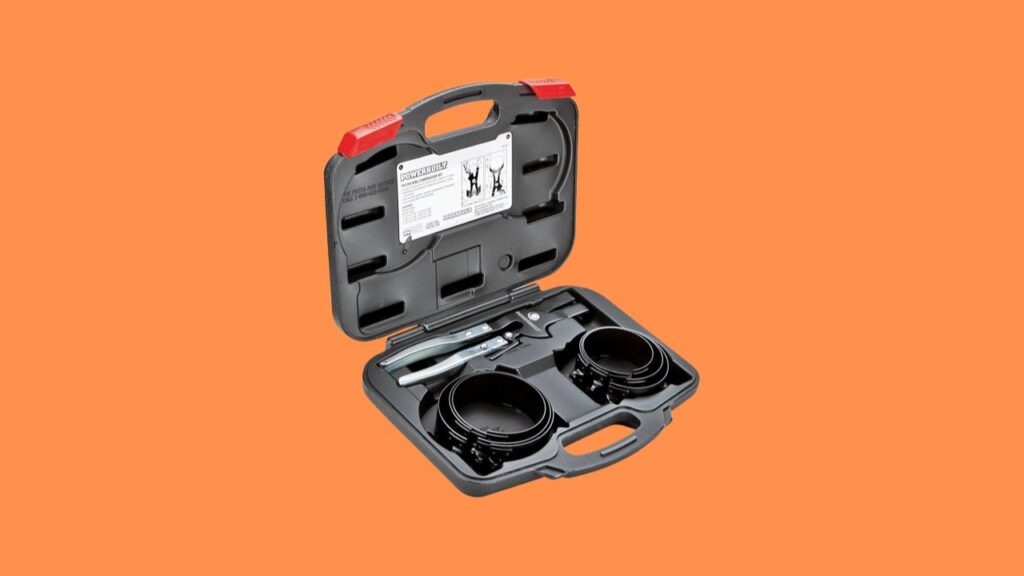
This article provides a detailed overview of the piston ring compressor tool, its purpose, types, and the correct way to use it, along with maintenance tips and safety precautions.
What is a Piston Ring Compressor Tool?
A piston ring compressor tool is designed to compress the piston rings, allowing for the smooth insertion of the piston into the engine cylinder. Piston rings are essential components of an engine, providing a seal between the piston and the cylinder wall to prevent the leakage of combustion gases and oil. Due to their tension, piston rings naturally expand outward, making them difficult to install without proper compression.
Types of Piston Ring Compressors
There are several types of piston ring compressors, each suited to different applications and preferences:
Band-Type Compressors:
- Description: These are adjustable metal bands that wrap around the piston and rings, compressing them uniformly.
- Usage: Commonly used for a variety of piston sizes. They are versatile and can be adjusted to fit different diameters.
Fixed-Size Compressors:
- Description: These are rigid tools designed for specific piston sizes and diameters.
- Usage: Ideal for precision work where the piston size is known. They provide a snug fit and are easy to use but lack versatility.
Ratchet-Style Compressors:
- Description: These have a ratcheting mechanism that allows for incremental tightening.
- Usage: Offer greater control over the compression process, making them suitable for high-precision applications.
Pliers-Type Compressors:
- Description: These use a plier-like mechanism to compress the piston rings.
- Usage: Useful for smaller pistons and rings. They are easy to use but may not provide as uniform compression as band-type compressors.
How to Use a Piston Ring Compressor
Using a piston ring compressor involves several steps to ensure proper installation and avoid damage to the piston rings or the cylinder wall:
Preparation:
- Clean the piston, rings, and cylinder to remove any debris or oil that could interfere with the installation.
- Lubricate the piston and rings with engine oil to facilitate smooth insertion.
Assembly:
- Place the piston ring compressor around the piston, ensuring it covers all the rings.
- Adjust the compressor (for adjustable types) to fit snugly around the piston.
Compression:
- Tighten the compressor to compress the piston rings. Ensure even compression to avoid damaging the rings.
- For ratchet-style compressors, use the ratcheting mechanism to gradually tighten the compressor.
Insertion:
- Align the piston with the cylinder bore.
- Carefully slide the piston into the cylinder. Tap gently on the top of the piston with a hammer handle or wooden dowel to help it slide in smoothly.
- Ensure the compressor is gradually released as the piston enters the cylinder to prevent ring expansion outside the cylinder.
Final Adjustments:
- Once the piston is in the cylinder, remove the compressor tool.
- Check that the piston moves freely within the cylinder and that the rings are properly seated.
Maintenance and Safety Tips
Tool Maintenance:
- Regularly clean the compressor tool to prevent the build-up of oil and debris.
- Inspect the tool for wear and damage before each use to ensure it operates correctly.
Safety Precautions:
- Wear safety glasses to protect your eyes from any debris or accidental slips.
- Ensure a firm grip on the tool and piston to prevent slips that could cause injury or damage.
- Work in a well-lit area to maintain visibility and precision.
Our best choice for piston ring compressor tool
Powerbuilt Piston Ring Compressor Tool Set
KEY FEATURES
- Hand powered
- Meets the ANSI standards
- Black and red color
- Instruction are given
PROS
- Best for the price
- The locking pliers actually worked unlike others
- The multiple sizes makes it convenient
- Easy to use
- Very sturdy
CONS
- The welded tabs has dimples inside of the rings
- Its not snap-on
Conclusion
The piston ring compressor tool is a vital asset for anyone involved in engine assembly or repair. It simplifies the installation of piston rings, ensuring they are properly seated without damage. By understanding the different types of compressors and following correct usage procedures, mechanics and DIY enthusiasts can achieve efficient and effective engine repairs. Proper maintenance and adherence to safety precautions further enhance the longevity and reliability of both the tool and the engine components.

